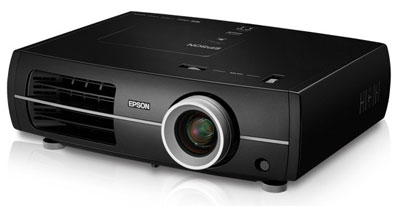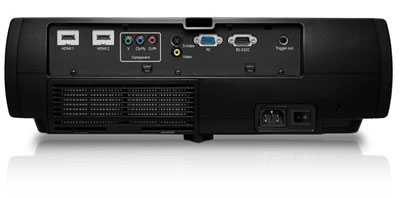|

Epson Pro Cinema Another Home Theater WinnerBy Jim Bray Epson has been turning out excellent front projectors for the home theater market, products that not only offer consumers a wonderful home theater experience, but which do it for a reasonable price. The PowerLite Pro Cinema 9500UB continues this noble tradition. I've been using Epson projectors as my reference units for a few years now, chiefly because of the aforementioned performance to value ratio. I try to use equipment that, while higher end than most of the products you find in the big box stores of the world, is still within reach of the consumer who wants that extra quality without remortgaging the home. This is also why I use Rotel, Oppo and JBL equipment as well, all of which is terrific stuff – and this latest Epson also offers everything I've come to like about the company's projectors, while upping the ante from the last generation. Consumers interested in a front projector – any front projector – should realize they need a dedicated home theater room with lighting that's controlled strictly. That's because, while today's projectors are plenty bright for enjoyable home theater viewing, too much ambient light spoils the show. Look at it as if you're in a real movie theater: they don't show you the latest 3D IMAX flick with the lights up! It's the same at home, and isn't that the whole point? The THX-certified PowerLite Pro Cinema 9500UB offers excellent picture quality, at a native 1080p resolution, with a contrast of up to 200,000:1. Contrast is one of the most important specifications: the blacker the blacks and whiter the whites the more real the picture looks and the better the apparent "depth" the picture can have. This is one of the reaons plasmas look so great. 200,000:1 is an excellent specification for an LCD. Heck, the first Epson projector I reviewed, back in 2007, boasted contrast of only 12,000:1, so you can see how the technology is evolving. That earlier Epson (the PowerLite Pro Cinema 1080) also boasted a brightness rating of 1200 lumens, which was more than adequate in the same home theater I used when reviewing this new Pro Cinema 9500UB. But the new model claims a brightness figure of 1600 lumens and, needless to say, it's even more adequate. Installation is straightforward, or it should be, anyway. Included in the box is all the equipment you'll need to hang it from your ceiling, short of the actual tools like screwdrivers and the like. And while it took us the better part of an evening to hang the original Epson, it was mostly because my ceiling seemed to object to having the unit there and was very uncooperative so far as letting us find studs, etc. On the upside, since the mounting equipment is the same for both (and common for many home theater projectors), swapping it out for the 9500UB only took a few minutes. It's always nice to mount the projector directly in front of your screen, for obvious reasons, but it isn't always possible. Fortunately, Epson gives you quite a bit of wiggle room here, with the projector adjustable for left/right and up/down correction. It's easy, too, thanks to the horizontal and vertical adjusting wheels mounted on the surface. Setup of the projector itself is also easy and of course you can set it for ceiling or table/floor/whatever mount at the flick of a setting in the easy-to-navigate menus.
Besides being THX-certified, the projector is also ISF calibrated right out of the box, and this undoubtedly doesn't hurt. In fact, the previous Epsons I reviewed, which weren't THX-certified but were ISF'd, were so close to being nigh on perfect out of the box that all it took was a minor tweak of the color to bring them into line – a correction so minor that if I hadn't used the calibration disc and the filters with which it comes I wouldn't have noticed it. So don't worry about all the adjustments you can do unless you're a real videophile or a professional installer whose client is particularly anal about the picture – chances are the 9500UB will please upon its initial unpacking. I did find a little bit of red seeping from the edges of some white lines of the test patterns, generally near the edges of the picture (I also noticed this with the previous Epsons I've tried), and while it was annoying to think the picture wasn't absolutely perfect I never noticed the problem when watching content other than test patterns or menu text. This might be correctable via all the tweaks you can do, but I didn't want to start messing about when the difference was so slight as to be virtually meaningless. As Star Trek's Spock might be wont to say, a difference which makes no difference, is no difference. On the upside, it did give me something negative so say, rather than just gibbering on about how great the projector is, so that's a bonus from a reviewer's point of view. The picture is customizable for whatever you're viewing, from HDTV to Blu-ray movies, sports or videogames. Its settings are: Vivid, Cinema Day, Cinema Night, THX, HD, SilverScreen, and x.v. Color. In practice, I left it on THX all the time, other than to check out the other settings to see how they looked, and I was very happy with it. Your eyes may be different, or your home theater needs, and that's why all these settings are there. Part of the reason I left it on THX is that 90 per cent of my viewing is of Blu-rays, with some HDTV and a bit of gaming, and the THX setting worked well enough with all of them to make me not want to drift from that setting – especially since I'd forget to change it back later and wonder why the next Blu-ray I reviewed looked so different! The heart of the Epson is its 3LCD, 3-chip optical engine combined with what they call a long-life E-TORL lamp and state-of-the-art lens by Fujinon. The lamp is said to be energy efficient and if you're concerned about Person Nature you can lower its light output to extend its life. You do lose some brightness and "realness" to the picture, but it's hardly a deal breaker. Epson also throws in (well, includes in the price) a second light bulb. Bulb life is estimated at up to 4,000 hours – which should be good for a few years of normal use. I ran the Epson on the brightest setting most of the time and preferred it that way. Since I review Blu-rays, I probably watch more movies than the average person. Add in Superbowls, Indy 500's and the like, and you have reasonably heavy use. Yet I've been using an older Epson full time for about a year and a half and have yet to hit 1000 hours which, if you average two hours per movie, is about 500 flicks. Obviously, I'm quite happy with the lamp life so far. One of the problems that plague LCD's is "lag", where the picture seems to shudder during some fast motion and pans. Epson fights this with what it says is an advanced, high-speed auto iris function that adjusts light output up to 60 times per second "to match every entertainment option". In reality, this lag is still there, but they do seem to have done a good job of trying to minimize it. Fan noise can also be an issue with a front projector and though I didn't measure the units with a sound pressure level meter, the 9500UB does seem quieter than the older models. It's quite unobtrusive, even during quiet passages of a program: it's there, but it isn't in your face. If you're really into high end home theater operation, Epson sells separately an anamorphic lens for "easy 2.35:1 viewing". They didn't send me one with my test unit so I watched 2.35 with the lens that came in the box, letterboxed from the unit's native 16x9 aspect ratio. I'd love to have tried the other lens, but have no complaints about the performance with the stock one. I watched a variety of programs, including the abovementioned Indy 500 in 1080i HD via my satellite provider, a selection of DVD's upconverted to 1080p via Oppo's terrific BDP-83 universal audio/video player (which I also used for playing Blu-rays). Naturally, the Epson is slave to the same "garbage in, garbage out" parameters as anything else is, but when fed a good signal its performance was simply lovely. When playing the Blu-rays I use as reference discs, titles such as The Fifth Element, The Dark Knight and, of course, Avatar, the picture was simply stunning. The Epson's excellent black levels gave a feeling of real depth – in fact, I enjoyed Avatar better on my 106 screen fed by the Epson 9500UB than I did when I saw it in 3D IMAX – it projected beautifully rich colors and a wonderfully detailed picture. This is, indeed, an excellent performer for its price. Inputs include two HDMI 1.3, one composite, one component, one S-Video, analog RGB and there's an RS-232 interface as well. In the real world, you'll probably only use HDMI and maybe component and RGB, but the others are there if you need them. The PowerLite Pro Cinema 9500UB retails for about $3999 U.S. Copyright 2010 Jim Bray Jim Bray's columns are available through the TechnoFile Syndicate. We welcome your comments! |
|
|||

 Picture adjustments are abundant and you can get pretty sophisticated with them if you want to. I found, however, that on the THX setting the projector was nigh on perfect right out of the box, according to the test patterns on the Digital Video Essentials HD Basics Blu-ray. Color was just fine, and the other tests – contrast, resolution, aspect ratio, etc., were all good to go.
Picture adjustments are abundant and you can get pretty sophisticated with them if you want to. I found, however, that on the THX setting the projector was nigh on perfect right out of the box, according to the test patterns on the Digital Video Essentials HD Basics Blu-ray. Color was just fine, and the other tests – contrast, resolution, aspect ratio, etc., were all good to go.